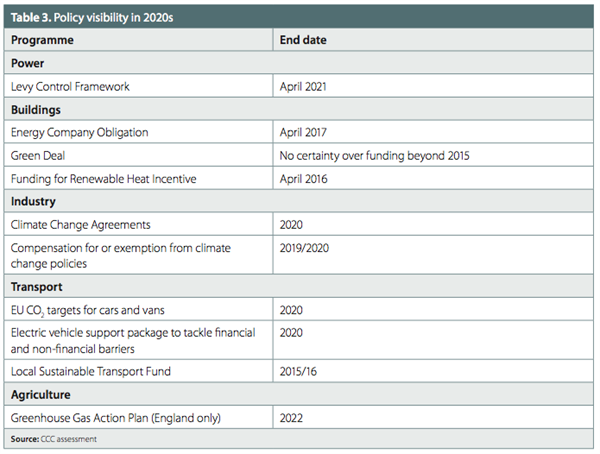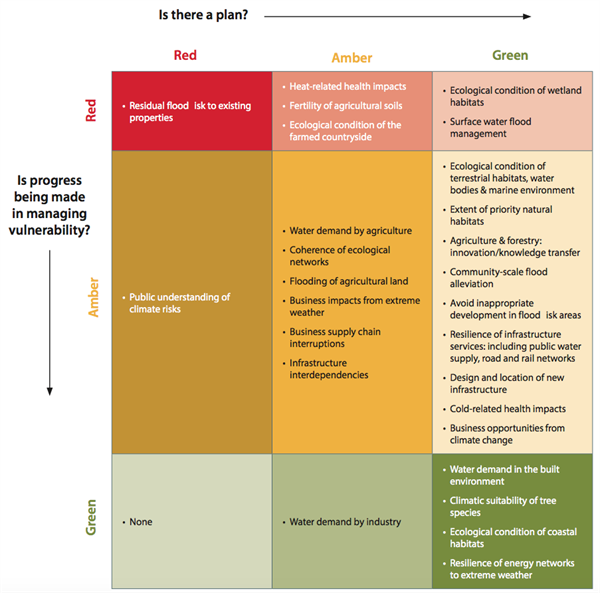
Government can’t take credit for steep 2014 emissions cuts, says Committee on Climate Change
Carbon Brief Staff
06.30.15Carbon Brief Staff
30.06.2015 | 12:01amIn its latest progress report, the Committee on Climate Change (CCC) delivers its verdict on how effective government policy has been in achieving the UK’s legislated climate targets.
The report is a story of good news with serious qualifications. In 2014, emissions fell dramatically in the UK, meaning that the government will comfortably remain within the carbon budgets outlining the rate of decarbonisation up to 2022.
But can the government take the credit for the reductions? And will it be able to continue at its current pace?
With a number of key policies set to expire, the future looks uncertain, says the CCC. Lord Deben, chairman of the CCC, says:
“The government has put into place a series of programmes which properly meets its [current] requirements, but it has very urgently to move those forward if it’s going to be in that same place in two or three years’ time, certainly in five years’ time.”
A good year
UK emissions fell steeply in 2014. But the government cannot take the credit, say the CCC.
Between 2009 and 2013, emissions fell at an annual average rate of just 1%. In 2014, the rate of reduction increased to 8%, which is impressive – on the surface.
This 8% fall puts the UK’s emissions 36% below 1990 levels. The UK is now well within its second carbon budget, covering the period 2013 to 2017, during which it needs to achieve a 29% reduction on 1990 levels. Even if emissions fell no further, it would meet its third carbon budget of a 35% reduction on 1990 levels by 2020.
But there are serious questions about whether these reductions can be sustained in the long term.
According to the CCC, the reductions were partly due to a mild winter, which meant there was low demand for heating. Adjusted to reflect this, the CCC says emissions would have still fallen by 6%. At this rate, the UK could achieve its 2050 target of an 80% reduction on 1990 levels 15 years early.
This was not the only one-off event which influenced 2014 emissions.
The largest reduction came from the power sector, says the CCC, where emissions were down by 18% in 2014. This can be attributed to a variety of factors. In addition to the mild winter, the share of UK electricity from imports rose by 2.2 percentage points – the UK does not include these emissions in its accounting.
Coal generation also decreased by 23%. As this is the most carbon intensive fuel used in the UK, this pushed down the UK’s 2014 emissions. But is this a permanent change? Half of it certainly is, with 1.2 gigawatts (GW) of coal capacity closing due to EU air quality directives, while 0.65 GW was converted to biomass.
Of the 20GW of coal remaining, generation fell by 18 terawatt hours (TWh) in 2014 – but this does not necessarily make for a permanent reduction, as the plants are still up and running.
Instead, the most indicative figure is the 4% reduction in emissions resulting from the increase in renewables generation, the CCC says. This is because almost all generation will need to come from low-carbon sources by 2030, and so it is this figure that represents the real progress towards the 2050 target. The 4% increase in 2014 put the UK’s share from low-carbon sources at 35%.
These are not the only reasons for the CCC’s caution. Emissions from the industrial sector were down by 6%, although it is not clear why, it says. Across the remaining sectors – buildings, transport and agriculture – which account for 56% of UK emissions, there were no significant reductions. Indeed, CO2 emissions from transport rose slightly. The CCC report says:
“The headline figures are dominated by the power sector and uncertain reductions in industry, whereas progress will be needed across all sectors to meet carbon budgets and the 2050 target.”
Mind the gap
The government has set itself a fourth carbon budget, covering the period 2023 to 2027. This was subject to review, with Chancellor George Osborne reportedly in favour of weakening the target. In 2014, the government decided to maintain current levels of ambition. The CCC also reported that the UK would not be able to hit its target under current government policies.
Yet in another case of qualified success in reducing emissions, the CCC’s new report says that the gap to the fourth carbon budget is now smaller.
Last year, it projected that emissions in 2025 would exceed the carbon budget by 45 million tonnes of carbon dioxide equivalent (MtCO2e) every year. The estimated gap in today’s report has shrunk to between 10 and 31 MtCO2e.
But, says the CCC, this is not because of intensified action, but because the government has revised its estimates of how much the UK would emit during 2023-27, regardless of policies. Projections of warmer winters are just one of the factors that have led the Department of Energy and Climate Change (Decc) to conclude that the UK will be emitting less in the next decade than it will be now.
While the baseline may have changed, there has been no advance in government policies that could close this gap – many of which are due to conclude during the course of the current Parliament.
The following table sets out policies that are set to expire in the near future. Several may also be a risk of funding cuts.

Source: CCC Mitigation Progress Report 2015
Matthew Bell, chief executive of the CCC, says:
“Fundamentally, the reason the gap exists is because we do not know as a Committee what is going to replace that whole set of programmes through the 2020s, and that is why the gap is there, and that’s why it’s important this Parliament address it, because this Parliament finishes in 2020.”
While there are a number of years before these policies expire, sending the policy signal is an urgent task for the government to commit to now, warned chairman Lord Deben:
“Let’s remember that all over the world people are now doing this. We’re no longer one of the leaders; this is now an international operationâ?¦so there are others places also seeking the investment that we want, and if you don’t have a continuing investment programme and a context in which people can securely invest, then people will make choices to go elsewhere.”
Adaptation
As part of the Climate Change Act, the government is required to assess the risks of climate change to our way of life, and come up with ways to address them. In 2013, the government published its first National Adaptation Programme ( NAP), which has a series of objectives for promoting adaptation in the UK.
With the next NAP due in 2018, today’s report is the first update from the Adaptation Sub-Committee (ASC) on how adaptation is progressing. The figure below summarises their assessment. The matrix divides up existing adaptation policies and plans from the NAP according to how well planned adaptation currently is (from left to right), and how much progress has been made (from top to bottom).
Matrix of adaptation priorities from the NAP, according to status of plans (left to right) and reducing vulnerability (top to bottom). Shading of grid squares shows: plans and progress are lacking (red), some evidence of planning and progress (amber), and plans in place and vulnerability falling (green). Source: CCC
So, for example, flood risk to existing buildings finds itself in the top-left grid square. This is because, the reports says, “the pace of fitting property-level flood protection measures is slow, and subsidising flood insurance will remove the financial incentive for flood alleviation by high risk households”. But for resilience of energy networks in the bottom-right square, the report finds that plans are in place and vulnerability to extreme weather is dropping.
Further steps
The report outlines 36 “specific and measurable” recommendations to “promote the pace and scale of climate change adaptation”. Each one is allocated to a government department to manage and is given a deadline for completion.
There are four particular areas of climate risk where further steps are needed, despite the progress made, the report says. These are: flood risk, heat stress, water scarcity, and impacts on natural capital and agriculture.
On flooding, for example, the report recommends that the Department for Environment, Food & Rural Affairs ( Defra) produces a strategy within the next year on what to do about the large number of homes expected to be at high flood risk in the coming decades.
This strategy should make use of the government’s new ‘ Flood Re‘ subsidised insurance scheme, but not in its current form, the report argues. The scheme caps household flood insurance in high risk areas, but provides “too much subsidy for too many people”, the report says, which removes the financial incentive for people to flood-proof their homes.
The report also suggests the Department for Communities and Local Government ( DCLG) should limit the paving-over of front gardens with impermeable surfaces. The proportion of front gardens in urban areas that are paved jumped from 28% in 2001 to 48% in 2011, which adds to flood risk, the authors say.
Among the other recommendations, a target for the DCLG is to reduce heat stress by creating a minimum standard for preventing overheating in new homes, and finding incentives to promote using passive cooling systems in existing ones.
Progress on all of these actions will reviewed by the ASC for their next report in June 2017.
Main image: UK coal power station.
-
Government can't take credit for steep 2014 emissions cuts, says Committee on Climate Change


